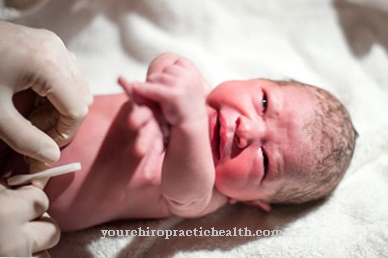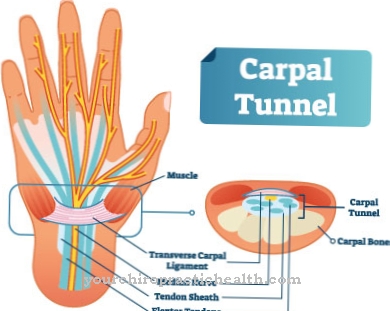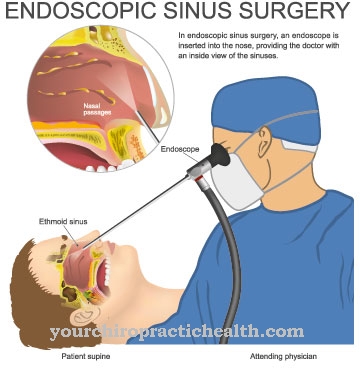At Hypoxia it is a lack of oxygen in the arterial blood. More generally, medicine also describes a low oxygen concentration in tissue. Hypoxia usually occurs as a result of other medical conditions.
What is hypoxia?

© Oleksandr - stock.adobe.com
The Hypoxia describes the lack of oxygen in the arterial blood. The oxygen is absorbed from the air in the lungs and transferred into fine blood vessels, so-called capillaries. From there, the heart and pulse beats pump the oxygen particles in the larger arteries through the body. In this way, oxygen-rich blood reaches organs and tissues, which absorb the oxygen. Capillaries redistribute the oxygen within the tissue; this finally penetrates to the individual cells that need it for their metabolism.
Cells that do not have enough oxygen die. The term hypoxia is also used in a more general sense to describe an insufficient supply of oxygen in certain parts of the body. In this case, despite sufficient oxygen in the blood, there is too little oxygen in the tissue, which causes reduced tissue breathing.
In medicine, tissue respiration is the term used to describe the exchange of oxygen and other respiratory gases within a group of cells, at the end of which they release carbon dioxide. The cells then excrete this metabolic product; the capillaries absorb the carbon dioxide and transport it back to the lungs via the bloodstream. There it is released back into the circulating air through exhalation.
causes
Various underlying diseases can be considered for the development of hypoxia. Anemia is a potential basis for hypoxia. This is a shortage of red blood cells. The body transports oxygen molecules via the red blood cells. A shortage of them leads accordingly to insufficient means of transport for the oxygen. Although the air we breathe contains enough oxygen in this case, the anemia means that the organism cannot absorb enough oxygen in its lungs: the result is hypoxia.
If, on the other hand, respiratory disorders are causing the hypoxia, medicine calls this respiratory hypoxia. Circulatory hypoxemia can also lead to hypoxia. In medicine, circulatory-related hypoxemia is a fundamental lack of oxygen in the blood that does not have to be limited to the arterial blood. A value of 200 ml oxygen per liter of blood is considered normal. A significantly reduced concentration of oxygen by 12 percent or more falls under the definition of hypoxemia.
Histotoxic or cystotoxic hypoxia describes a lack of oxygen in the tissue, which is caused by a blockage in cell respiration. The lack of enzymes and vitamins can also trigger a lack of oxygen in the tissue. Physiological shock states, which cause poor circulation, represent a further potential cause; here medicine speaks of circulatory hypoxia. In addition, smoke inhalation or near-drowning cause the medical condition.
Symptoms, ailments & signs
Characteristic symptoms of hypoxia are changes in breathing, increased pulse and / or chest pain. Mental symptoms such as baseless euphoria, perceived lightness or delirium may also indicate hypoxia. In addition, hypoxia may cause dizziness, weakness, and general malaise.
If the body tissue is not supplied with oxygen for a longer period of time, the circulation can be weakened or even unconscious. In this case, difficulties in perception, subjective perception of turns, tremors, feelings of heat and cold, as well as sweating are signs of a critical condition. Nausea without actual gastrointestinal discomfort may also appear.
Basically, the symptoms of hypoxia manifest themselves in various forms; The typical symptoms that occur in the context of hypoxia are unspecific symptoms that can also occur with numerous other diseases. For this reason, the presence of the symptoms mentioned is not a sufficient criterion to infer hypoxia; only a medical examination can lead to a correct diagnosis in an individual case and enable targeted treatment.
Diagnosis & course of disease
If hypoxia is suspected, a special test can bring clarity. Patients breathe in a controlled mixture of breathing gases. The exact composition of the gas mixture varies depending on which of the various hypoxia tests the treating professionals choose. A subsequent measurement of the oxygen concentration in the blood provides information on whether hypoxia is present.
Complications
The lack of oxygen in the blood can lead to various complaints and complications, which in the worst case can be life-threatening for the patient. There is a general feeling of illness and severe dizziness. The patient also suffers from vomiting and nausea and from a greatly reduced resilience.
This significantly limits everyday life. In the further course of the disease this can lead to unconsciousness, which can injure the patient. There is also pain in the extremities and the affected person may suffer from sleep problems, which lead to general irritability. In many cases, hypoxia cannot be diagnosed immediately because the symptoms are not characteristic of the condition.
If there is a complete undersupply of a certain region of the body with oxygen, this region can in the worst case die or be permanently damaged. The treatment is therefore always acute and aims at the supply of oxygen to the undersupplied tissue. There are no complications with the treatment itself. However, consequential damage can occur, which not infrequently lead to the death of the patient.
When should you go to the doctor?
If changes in breathing, chest pain, and high blood pressure are noticed, the cause may be hypoxia. A doctor should be consulted if the symptoms persist for more than two to three days or if they rapidly increase in intensity. If symptoms such as dizziness, malaise or general physical weakness are noticed, a doctor must also be called in. Medical advice is required at the latest when you feel hot or cold, sweating or dizziness that cannot be traced back to any other cause.
Patients who suddenly feel nauseous or feel unwell for a long time are best to speak to a doctor. People who suffer from anemia are particularly at risk. Disturbances in breathing or the circulatory system can also lead to hypoxia. People who belong to these risk groups should inform their family doctor about the symptoms mentioned. They can carry out the necessary examinations and clarify and treat hypoxia before serious complications set in.
Doctors & therapists in your area
Therapy & Treatment
As hypoxia progresses, there may be a complete lack of oxygen in a particular tissue or part of the body. Doctors refer to this condition as anoxia. The transition between hypoxia and anoxia is fluid. Severe oxygen deficiency, especially over long periods of time, can potentially damage organs - the brain is particularly affected. In this case, medicine speaks of cerebral hypoxia.
The treatment of hypoxia depends largely on the individual causes; In the case of an underlying disease, the focus is on therapy for the underlying disease. For this reason, there is no universal standard. Under certain circumstances, doctors supply additional oxygen for treatment via the breath or directly to an undersupplied tissue.
You can find your medication here
➔ Medication for shortness of breath and lung problemsprevention
Preventive measures for hypoxia play a role when there is a disease that can typically lead to hypoxia. Basically, the treatment of the underlying disease is in the foreground for prevention and therapy of hypoxia. In order to avoid hypoxia, especially in children, it is important to prevent mechanical influences from interrupting the air supply and thus possibly leading to subsequent hypoxia.
Aftercare
Follow-up care for hypoxia is similar to preventive measures. These are used when those affected suffer from an illness that triggers hypoxia. So it is primarily about the treatment of the causative disease. To minimize the risk in children, parents should take care that breathing is not restricted by mechanical influences. Small objects pose a great danger here.
It is also important for children and adult patients to observe their breathing and to pay attention to certain body signals. High blood pressure, chest pain or similar symptoms are typical signs. If such problems occur in an intense form or long-term, a doctor should be consulted. In the course of follow-up care, those at risk should pay particular attention to dizziness or malaise.
A good self-assessment is very helpful here. Sudden panic can aggravate the dizziness or sweating, but it can also be a typical signal. People with anemia should pay extra attention and watch their breathing. Otherwise there is a risk of faintness attacks. A healthy cardiovascular system, on the other hand, is less vulnerable. Therefore, doctors often recommend consistent training and a balanced diet to those affected.
You can do that yourself
Since hypoxia usually occurs as a result of other diseases, the underlying disease should always be treated in the foreground.
However, hypoxia can be avoided very easily in young children by placing dangerous objects out of reach. This is especially true for plastic bags or small objects that children can easily choke on. Children should also be supervised around water at all times to avoid accidents and thus hypoxia. In the event of an acute emergency, mouth-to-mouth resuscitation must be carried out immediately. This also applies if the person concerned has already lost consciousness. A stable side position must also be ensured. In an emergency, the emergency doctor must also be notified. The earlier the emergency doctor arrives, the higher the likelihood of a mild course of the disease without complications.
A healthy lifestyle also has a positive effect on the disease. Above all, smoking should be avoided. Direct treatment of the underlying disease can usually only be carried out by a doctor. It cannot be predicted whether this will lead to a complete healing.

.jpg)










.jpg)



.jpg)










.jpg)
